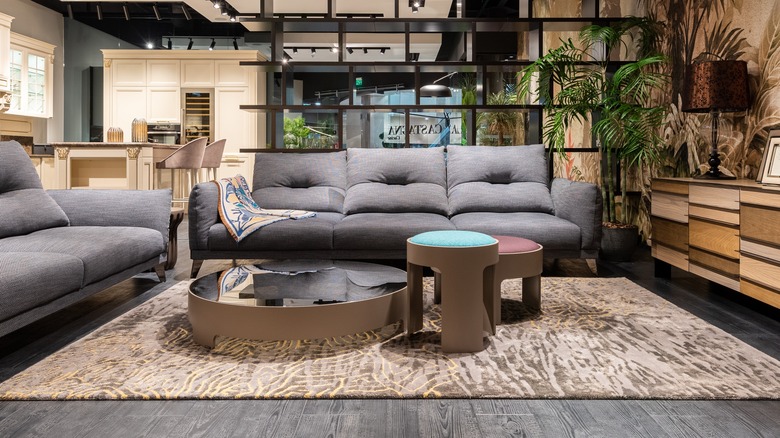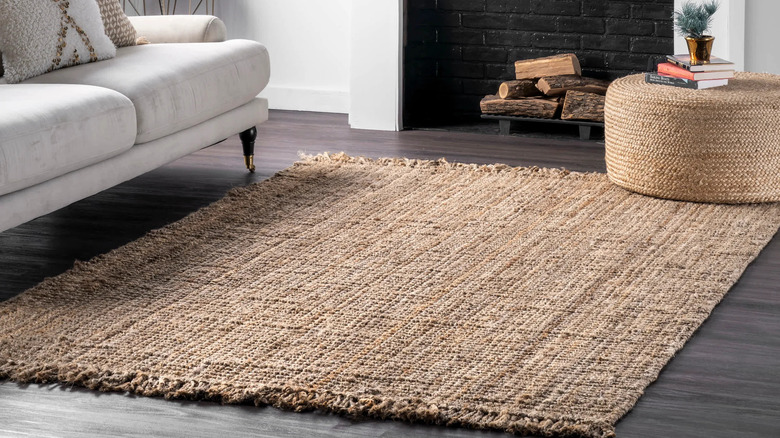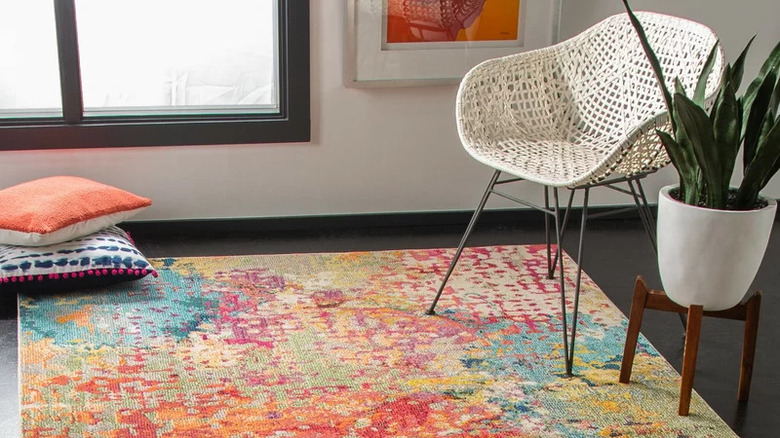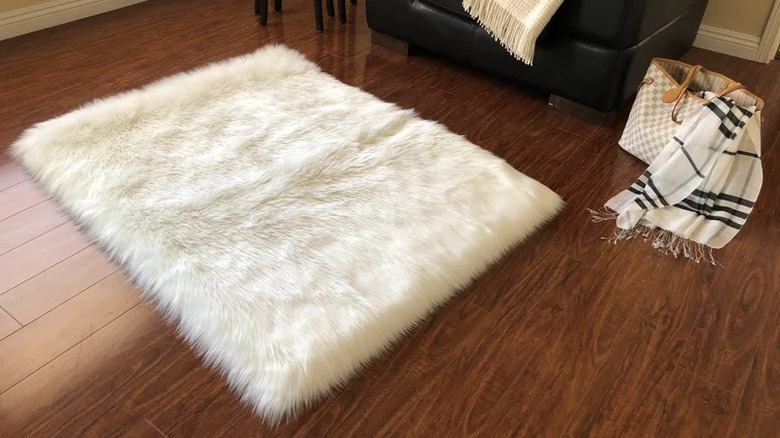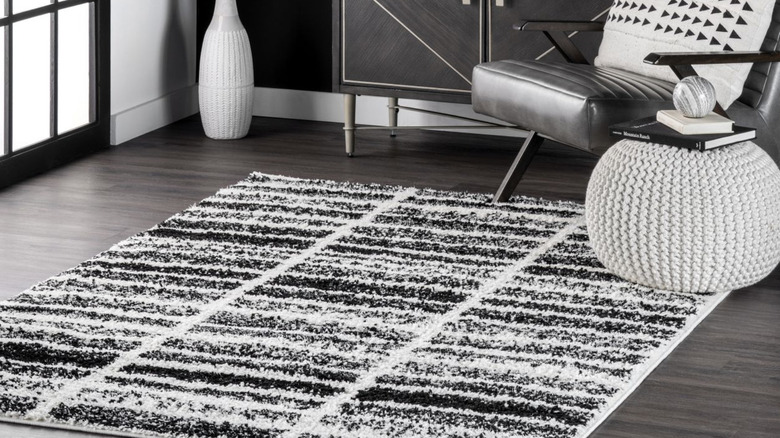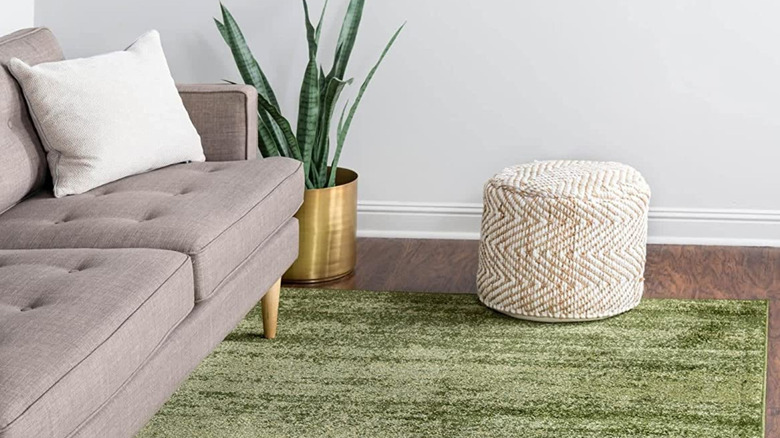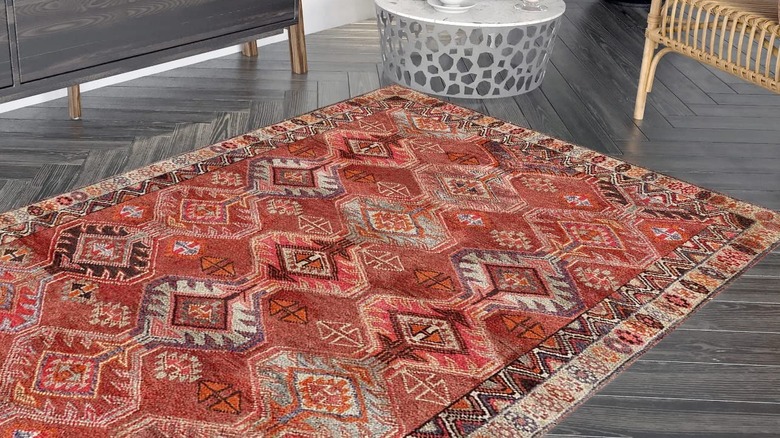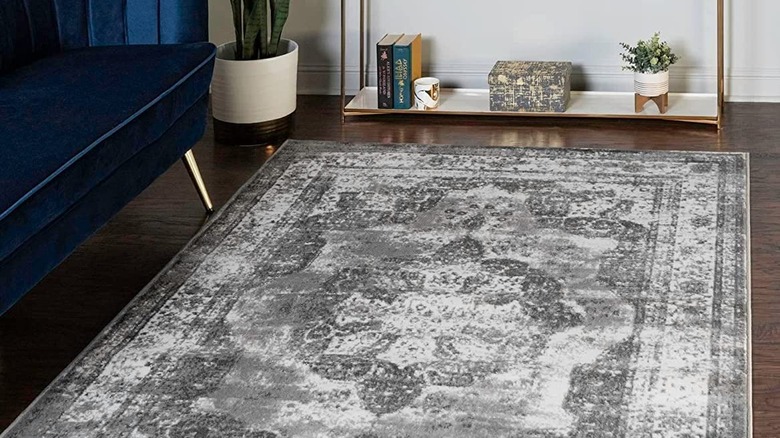These Are The Best Rug Colors For Dark Floors
Rugs play a humble role in interior design. They are the key pieces that can make or break a room's aesthetic appeal. Many people concern themselves with how a rug will look with their furniture but forget to consider the floor beneath it. But a rug's color, shape, and pattern all play a part in determining if it complements the original flooring surface. Dark flooring, such as rich hardwoods, dusky painted tiles, and dyed carpeting, can be tricky to match if you aren't sure what to look for.
In order to create a cohesive design, amateur and professional home decorators must have some understanding of color theory. Understanding which colors fit together and how contrasting shades can be connected through darker or brighter tones can greatly up your interior decorating skills. With this in mind, below are the best rug colors that contrast and complement dark flooring, boosting your chances of successfully choosing the perfect rug for your room.
Beige and natural tones enhance an earthy look
The color beige has a way of making rooms feel warm and pleasant, and it's often paired with other neutral shades or vibrant colors to create a soothing atmosphere. No matter where you choose to lay beige or neutral-toned rugs, they add an earthy touch with their natural colors. This type of rug is especially recommended if you have dark wood flooring with reddish or deep brown undertones. The richness of the wood contrasts sharply with natural pale-toned hues.
Since beige rugs correlate well with many furniture styles, including bohemian, contemporary, modern, rustic, and traditional looks, they are an easy addition to dark-floored rooms. The beauty of these rugs is that they can subtly blend with other neutral colors in a room or stand out as the one source of light in a dark color scheme. To add a more natural or earthy feel, opt for jute rugs, which use woven fibers from dried plants to make a thick and durable textile. If you prefer rugs that are softer and less rugged than rough weaves, many beige rugs are made of cotton, wool, or synthetic materials and made in a tufted fashion. "Tufted" refers to textiles with areas of higher and lower piles that create a physically textured pattern in the fabric. This makes a rug more visually complex without disrupting neutral color schemes.
Pastel and bold rainbow add a splash of color
Rainbow-colored textiles are a sharp contrast from neutral-toned rugs and also enhance rooms with dark flooring. Plus, they are a really effective way to make a big statement in a space. Interior designer, Sarah Barnard tells Homes and Gardens, "Rugs are increasingly doubling as works of art in many homes, with a focus on more unique and illustrative designs, shapes, and palettes. Many of these statement rugs include more saturated, vivid colors, contributing to the rugs as the room's focal point."
These rugs look stunning in bohemian, retro, and eclectically decorated spaces but can fit right in with modern and traditional aesthetics too. The colors pop on dark flooring and add zest to a room. The rainbow design makes dark-themed rooms appear less solemn and muted, creating a more versatile space. Add brighter decorative pieces, like bold throw pillows, abstract artwork, and live or faux plants for a unique and cheerful vibe. These items can also be matched to the shades on the rug to create a highly unified style. Look for rainbow rugs made in a flatweave style since the patterns look busy enough without being high pile designs.
White offsets the darkness
White rugs used to be a decorative element only recommended for those without small children and pets since their pristine color is more vulnerable to stains and dirt. However, in recent years, machine-washable synthetic rugs have made white fabrics more practical for anyone's home. If you love the sharp contrast between a white area rug and dark flooring, there is no reason to hesitate on this hue, even if you have a busier household. White rugs of all textures and sizes, including shag, cotton, and woven materials, can be made from washable polyester, allowing you to use this classic look to brighten up any room.
Dark floors make dining rooms, living rooms, offices, and bedrooms feel compact and cozier. So, adding a white rug is useful for keeping a room from feeling too cramped. It draws attention to the darker elements in a room by highlighting them as accent pieces. The biggest perk of these rugs is that they work with most interior design styles. White is a natural color that complements other neutrals, like browns, grays, and off-whites, as well as bolder hues from primary color palettes. They're also useful in layering underneath other rugs if you want to emphasize other patterns or add texture.
Black and white provide an ultra-modern feel
White isn't only gorgeous in solid color form; black and white color schemes are timeless in interior design. They're ideal for accentuating glamorous and minimalistic room styles alike. With this in mind, black and white rugs are classic additions to rooms with dark features, such as deep brown hardwood floors and dark furniture. These can provide splashes of brightness with white but still maintain a dark vibe with contrasting patterns. Using this classic and sophisticated combination adds an element of poshness to your home. These colors are also representative of Yin and Yang, a philosophical concept ascribed to opposing forces, which brings balance and harmony to a room.
These rugs are typically styled in geometric, plaid, and striped designs, maintaining their simple but alternating appearance. You can place them over dark grays, browns, and other unique floor shades, as the color scheme easily melds with many options. They work great as large area rugs but can also add visual interest in hallways or entryways with dark floors.
Olive and sage greens soothe the atmosphere
Olive and sage green are earthy colors that never go out of style, as their affinity with nature makes them naturally aesthetically appealing. Green shades give off a harmonious vibe, especially when paired with other colors reminiscent of plant life, such as browns and yellows. Following this logic, it's sensible that olive and sage-colored rugs make a great addition to rooms with dark flooring by creating nature-inspired atmospheres.
Hues of olive and sage mixed with warm colors are popular color schemes for rustic, classic, and modern rooms. The natural tones of pastel olive-colored rugs can create the illusion of a larger space, and they look best when paired with light-colored couches and walls. Sage green has softer and cooler undertones than olive, making these rugs more idyllic for dark-floored rooms intended to be relaxing and peaceful spaces like nurseries, bedrooms, and dens. You can find green rugs in high and low pile, and many of them are accented with oranges, yellows, and other greens that maintain the nature-esque appearance.
Kilim-style in oranges and reds brings sophistication
Few accessories make a house look as regal and stately as a traditional-style rug on an authentic hardwood floor. Kilim rugs are a classic style of rug influenced by ancient Persia, Turkey, and other African, Asian, and Middle Eastern cultures. They are recognizable for their symmetrical geometric and floral patterns, which are traditionally handwoven on looms, and the finished rugs come in various color schemes. Although the colors are versatile, many of these rugs are woven in warm colors, like reds, yellows, and oranges, and they look most elegant when spread over darker floorboards. They can also create a sophisticated and internationally-inspired interior, and you can even layer these over solid color rugs to make a statement.
Since Kilim rugs are so diversified, there is no one best option for all dark floors. These rugs are typically made as flatweave, meaning they're very thin and won't detract from the beauty of rich hardwood. However, they can also work well over dark carpet. Texas-based designer Ashley Moore tells AP News that she has a Morccan-patterned runner to add color to her kitchen but also uses one in her bedroom to "define the space." She explains, "My carpet in the bedroom is actually really dark, so I have a bright rug on it now."
Grays can be striking or subtle
Gray is often associated with simplicity, modesty, and humility. However, when used in interior design, it can encapsulate either boldness or subtlety. This makes it an excellent option for either masking or drawing attention to dark flooring. Gray hues can be used in everything from coastal and contemporary to rustic and traditional styles. Plus, it can run the gamut between warm and welcoming and cool and sophisticated. Richard Misso, interior design director tells Livingetc, "Grey can literally pair with any color. It comes in so many glorious shades and tones it often has hints of different colors."
Light and mid-toned grays both look stunning against dark brown flooring. Mahogany flooring plays perfectly off of grey as the cooler hue provides a balancing effect. Warmer greys can bring more character to black and cool brown stained floors. Plus, you can find gray rugs that are solid in color, but many flatweave options feature geometric, floral, abstract, and internationally-inspired patterns to fit any style.
